Asbury and West United Church 1958 sanctuary was designated following a July 2010 city planning division report
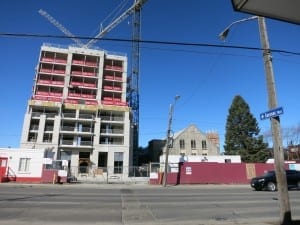
Asbury and West United Church redevelopment. View looking west across Bathurst Street from Woburn Avenue. Jaan Pill photo
The story of the Asbury and West United Church redevelopment appears very straightforward to me.
I can readily follow the story because I lived on Saranac Blvd. from 1983 until 1991 and know the area well. The church is at the southwest corner of Saranac Blvd. and Bathurst Street. A Google Map of the area is included at the end of this blog post.
My knowledge of the area makes it easy for me to follow the narrative.
A friend once spoke with me about an apple orchard that existed decades ago – I guess he must have seen it around the 1950s – where Lawrence Plaza now stands at Lawrence Avenue and Bathurst Street.
A July 9, 2010 city planning division document related to the church notes that Lawrence Plaza is purportedly the first shopping plaza in Toronto. I imagine a number of places might make that claim. [Click on link in previous sentence to access the document.]
Only the 1958 sanctuary was designated as a heritage resource; the other buildings dating from the 1890s were demolished
I’ve encountered several accounts of the Asbury and West story in which a narrator expresses a degree of surprise that the older 1890s buildings were not designated as heritage properties, whereas the 1950s-built sanctuary building was so designated.
A long-time Saranac Blvd. resident remarked to me recently that the 1890s part of the church didn’t present itself as an architectural gem. That is also the gist of the storyline of the July 2010 staff report which outlined the recommended designation strategy.
Ontario Heritage Act
The City of Toronto staff report is a checklist-driven, evidence-based official document, written in relatively neutral language. The Asbury and West United Church, on its website, also expresses views about the redevelopment process. The reports at the website are written in language that offers a good sense of how a particular church might approach heritage preservation questions when it happens to be in the role of property owner and developer.
Each property owner will approach legislation such as the Ontario Heritage Act, and the methods by which the Act is implemented by a jurisdiction such as the City of Toronto, from a characteristic perspective.
Expressions such as “How dare you tell us what to do with our property” may arise when a church must decide what to do with its buildings when a congregation diminishes and building costs increase.
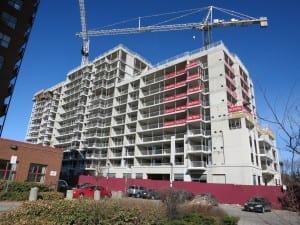
The Options for Homes condo at the Asbury and West United Church site is currently (April 2013) under construction. Jaan Pill photo
It can be expected, I would argue, that an owner is likely to have an owner’s perspective.
It’s helpful to have a sense of empathy, I would argue as well, in seeking to understand that perspective. City officials who are tasked with the implementation of heritage preservation legislation will likewise likely have a perspective that corresponds – closely or loosely, as the case may be – with the intent and operational features of the Ontario Heritage Act.
Local residents will have a perspective based upon, among other things, the experience of a person walking down the street and observing a heritage place of worship in her or his line of vision. As Jane Jacobs wrote in The death and life of American cities (1961), there’s a lot we can learn by walking down the street and engaging in conversations about what it is that we see.
Occasionally, the owners may also be local residents in which case several ways of seeing may be available to a given individual. Local politicians, community organizations, and media will likewise bring particular interests and viewpoints to the topics at hand.
Fittingly technical language
The tone of the July 9, 2012 staff report, which is the basis of much that I know about the Asbury and West redevelopment, is fittingly technical, to use an expression the urban geographer Jason Hackworth employs in another context.
Whatever the language in such a document may be, as Hackworth notes (see below) regarding social housing legislation, the driving force behind it is decidedly political and the effects of such a report are pronounced.
This point comes to mind because a recent paper by Hackworth underlines the fact that municipal planning parameters – expressed in fittingly technical language – have a powerful impact on church redevelopment processes in Toronto and elsewhere.
In a chapter about social housing in Canada, in How the other half lives: Lower income housing in a neoliberal world (2009), Hackworth speaks (p. 266) of the fact that in Ontario, “the primary vehicle for codifying the Harris-Eves neoliberal order is the Social Housing Reform Act – a complicated, 184-page document that spells out the relationship between local providers and formal government in the province.”
“The tone of the Act,” he notes, “is fittingly technical, but the impetus was markedly political, and its affects on the sector have been pronounced. The overall effect has been to create pressures that force local providers to behave more like for-profit organizations.”
History of Asbury and West United Church
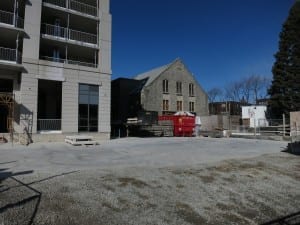
On left is Options for Homes condo under construction. On right is 1958 Asbury and West United Church sanctuary building. The condo will wrap around the south and west sides of the sanctuary. Jaan Pill photo
Asbury and West United Church, a church complex incorporating an 1899 church with additions dating to the 1950s, is located at the southwest corner of Saranac Blvd. and Bathurst Street, north of Lawrence Ave. West. The property was in July 2010 the subject of a rezoning application that proposed to amend the local zoning bylaw by allowing the construction of a 13-story residential building with commercial uses at grade and underground parking. A May 2010 proposal had proposed to incorporate the 1958 sanctuary of the church into the redevelopment.
In the staff report dated July 9, 2010, the Acting Director, Policy and Research, City Planning Division, proposed the designation of the 1958 part of the church property under the Ontario Heritage Act.
Integrity of original 1899 church negatively impacted by changes that were made starting in 1951
The staff reports notes that the property at 3180 Bathurst St. contains Asbury and West United church, where the original church (1899) was relocated and altered in the 1950s with the addition of an administrative wing and a new sanctuary.
The report concluded that the sanctuary, completed in 1958, which blends a traditional façade with a modern interior, meets the criteria for designation under the Ontario Heritage Act. The report also determined that the integrity of the original 1899 church had been negatively impacted by additions to the site that had been made starting in 1951.
According to the staff report, the 1958 structure is a unique example of a church building that combines Modern Gothic stylistic elements on the exterior with a contemporary interior reflecting the postwar Modern era in architecture.
It adds (p. 3 of the document): “An institution of importance and a local landmark in North York, Asbury and West United Church was designed by the notable Toronto architect, Douglas E. Kertland.”
Cultural heritage value
The document discusses the historical importance of the church to the North York community. The church, which began in the early 19th century as Asbury Wesleyan Methodist Church, moved to its present location in 1899, where it was known as Asbury Methodist Church and (after 1925) as Asbury United Church.
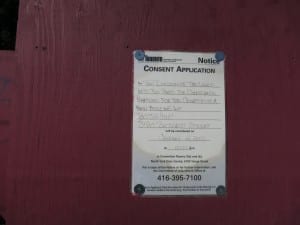
The text of a notice of a Jan. 2, 2012 Committee of Adjustment (North York Panel) meeting reads: "Consent application for the division of lands into two parts for conveyance purposes for the creation of a new building lot." The notice is posted on a construction hoarding at 3180 Bathurst Street. Jaan Pill photo, April 2013
After the Second World War the church witnessed the transformation of its surroundings from a farming hamlet to a residential subdivision and then city neighborhood. The process reminds me of the transformation of the Col. Samuel Smith homestead in Long Branch from a farm in the countryside to the same farm surrounded by an encroaching city.
The report adds (p. 7): “Contextually, as an institutional building placed in a park-like setting on an expansive corner lot, Asbury and West United Church is a local landmark on Bathurst Street, north of Lawrence Ave. West.”
We may add that a park-like setting is in some cases an ideal location for a condo.
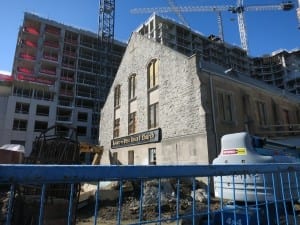
A not-for-profit condo is under construction on the south and west sides of the 1958 sanctuary. Jaan Pill photo
Options for Homes
The church’s website notes that when the church decided to sell some of its land, they interviewed a wide range of developers. They chose Options for Homes. The development is entitled Cranbrook Village. The Options for Homes website notes:
“Options for Homes Non-Profit Corporation (‘Options’) is dedicated to providing quality homes in great communities at the best possible price. Options strives to bring home ownership within reach for households with a wide range of income levels, from young families to those downsizing from a larger home. This goal has been achieved with all of our communities.”

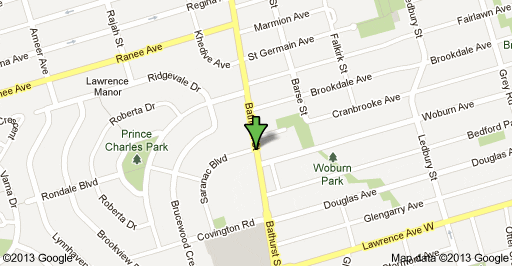
Do you have anyone there who would check records for genealogical facts.